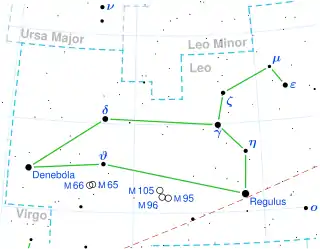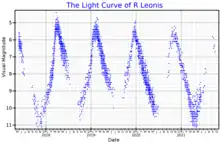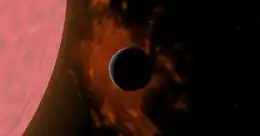 | |
| Observation data Epoch J2000.0 Equinox J2000.0 | |
|---|---|
| Constellation | Leo |
| Right ascension | 09h 47m 33.4840s[1] |
| Declination | +11° 25′ 43.823″[1] |
| Apparent magnitude (V) | 4.4 - 11.3[2] |
| Characteristics | |
| Spectral type | M6e-M8IIIe-M9.5e[2] |
| Apparent magnitude (J) | −0.7[3] |
| B−V color index | 1.26 |
| Variable type | Mira |
| Astrometry | |
| Proper motion (μ) | RA: 6.132[1] mas/yr Dec.: −53.097[1] mas/yr |
| Parallax (π) | 14.0566 ± 0.8378 mas[1] |
| Distance | 372 ly (114[4] pc) |
| Details | |
| Mass | 0.7[5] M☉ |
| Radius | 299,[6] 320-350[7] R☉ |
| Luminosity | 3,537[4] L☉ |
| Temperature | 2,890[6] (2,930 - 3,080)[7] K |
| Other designations | |
| Database references | |
| SIMBAD | data |
R Leonis is a red giant Mira-type variable star located approximately 370 light years away in the constellation Leo.

The apparent magnitude of R Leonis varies between 4.31 and 11.65 with a period of 312 days. At maximum it can be seen with the naked eye, while at minimum a telescope of at least 7 cm is needed. The star's effective temperature is estimated 2,890 kelvins and radius spans 299 solar radii (208,000,000 kilometres; 1.39 astronomical units),[6] roughly Mars's orbital zone.
Possible planet

In 2009 Wiesemeyer et al.[5] proposed that quasi-periodic fluctuations observed for the star R Leonis may be due to the presence of an evaporating substellar companion, probably an extrasolar planet. They have inferred a putative mass for the orbiting body of twice the mass of Jupiter, orbital period of 5.2 years and likely orbital separation of 2.7 astronomical units. If confirmed such a planetary object could likely be an evaporating planet, with a long comet-like trail as hinted by intense SiO maser emissions.
| Companion (in order from star) |
Mass | Semimajor axis (AU) |
Orbital period (days) |
Eccentricity | Inclination | Radius |
|---|---|---|---|---|---|---|
| b (unconfirmed) | ≥2 MJ | ≥2.7 | 1898 | 0 | — | — |
References
- 1 2 3 4 5 Brown, A. G. A.; et al. (Gaia collaboration) (August 2018). "Gaia Data Release 2: Summary of the contents and survey properties". Astronomy & Astrophysics. 616. A1. arXiv:1804.09365. Bibcode:2018A&A...616A...1G. doi:10.1051/0004-6361/201833051. Gaia DR2 record for this source at VizieR.
- 1 2 "GCVS Query=R Leo". General Catalogue of Variable Stars @ Sternberg Astronomical Institute, Moscow, Russia. Retrieved 2012-08-22.
- ↑ "V* R Leo". SIMBAD. Centre de données astronomiques de Strasbourg. Retrieved 2012-08-21.
- 1 2 McDonald, I.; De Beck, E.; Zijlstra, A. A.; Lagadec, E. (2018). "Pulsation-triggered dust production by asymptotic giant branch stars". Monthly Notices of the Royal Astronomical Society. 481 (4): 4984. arXiv:1809.07965. Bibcode:2018MNRAS.481.4984M. doi:10.1093/mnras/sty2607. S2CID 118969263.
- 1 2 Wiesemeyer; et al. (2009). "Precessing planetary magnetospheres in SiO stars?. First detection of quasi-periodic polarization fluctuations in R Leonis and V Camelopardalis". Astronomy and Astrophysics. 498 (3): 801–810. arXiv:0809.0359. Bibcode:2009A&A...498..801W. doi:10.1051/0004-6361/200811242. S2CID 14531031.
- 1 2 3 De Beck, E.; Decin, L.; De Koter, A.; Justtanont, K.; Verhoelst, T.; Kemper, F.; Menten, K. M. (2010). "Probing the mass-loss history of AGB and red supergiant stars from CO rotational line profiles. II. CO line survey of evolved stars: Derivation of mass-loss rate formulae". Astronomy and Astrophysics. 523: A18. arXiv:1008.1083. Bibcode:2010A&A...523A..18D. doi:10.1051/0004-6361/200913771. S2CID 16131273.
- 1 2 Fedele; et al. (2005). "The K -Band Intensity Profile of R Leonis Probed by VLTI/VINCI". Astronomy and Astrophysics. 431 (3): 1019–1026. arXiv:astro-ph/0411133. Bibcode:2005A&A...431.1019F. doi:10.1051/0004-6361:20042013. S2CID 15500217.
- ↑ "Download Data". aavso.org. AAVSO. Retrieved 1 October 2021.
External links
- AAVSO Variable Star of the Month. April, 2001: R Leonis Archived 2003-11-06 at the Wayback Machine